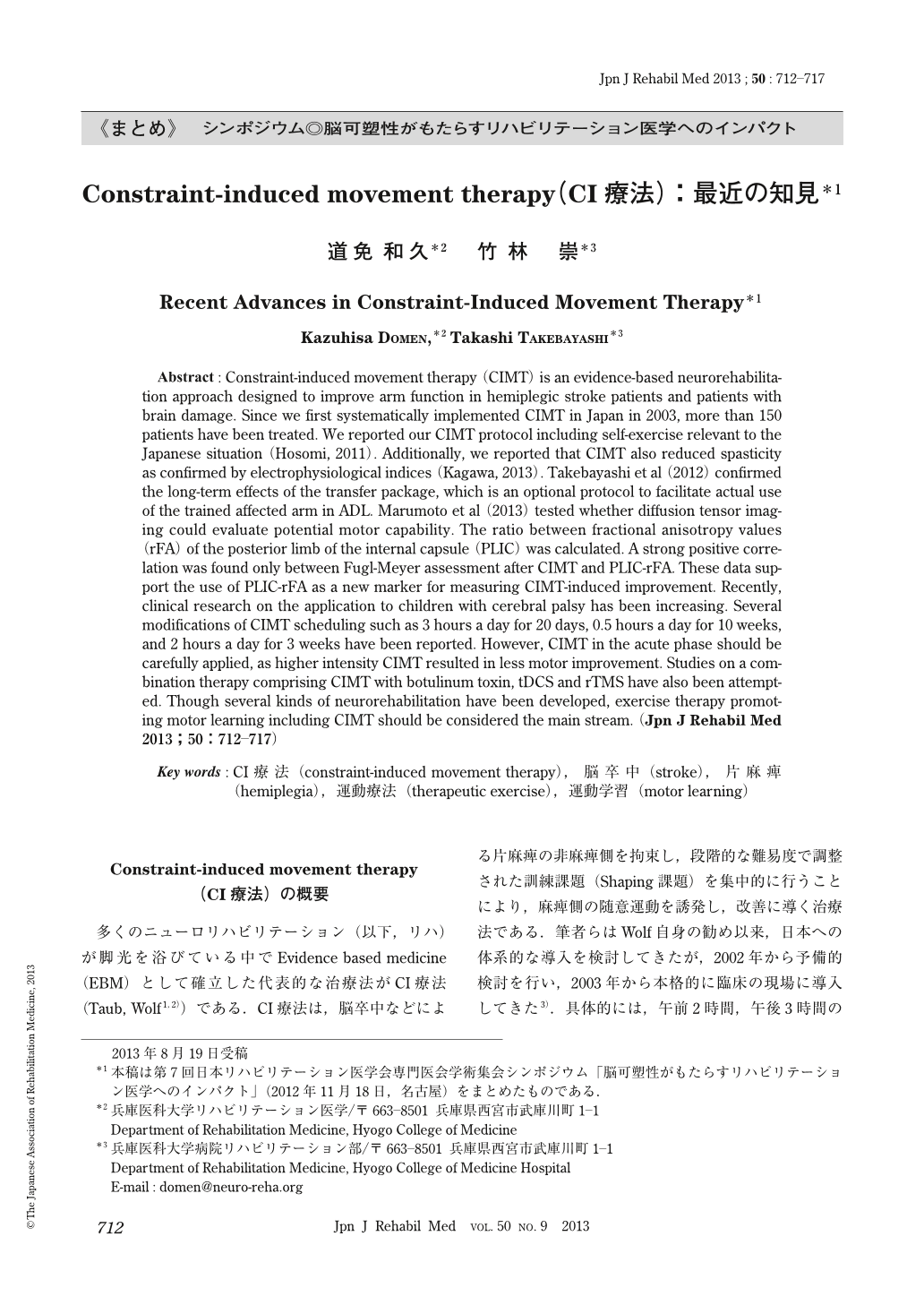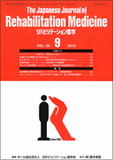Japanese
English
- 販売していません
- Abstract 文献概要
- 1ページ目 Look Inside
- 参考文献 Reference
Constraint-induced movement therapy(CI療法)の概要
多くのニューロリハビリテーション(以下,リハ)が脚光を浴びている中でEvidence based medicine(EBM)として確立した代表的な治療法がCI療法(Taub,Wolf1,2))である.CI療法は,脳卒中などによる片麻痺の非麻痺側を拘束し,段階的な難易度で調整された訓練課題(Shaping課題)を集中的に行うことにより,麻痺側の随意運動を誘発し,改善に導く治療法である.筆者らはWolf自身の勧め以来,日本への体系的な導入を検討してきたが,2002年から予備的検討を行い,2003年から本格的に臨床の現場に導入してきた3).具体的には,午前2時間,午後3時間の訓練時間を確保し,全体の40%を作業療法士がマンツーマンで実施し,残り60%は自主訓練とした4).これを週に5日間,2週間にわたって合計10日間の療法を行うこととした.日本の診療体制で実施可能な筆者らのプロトコールは,CI療法のreview5)でも紹介されている.
また筆者らは,outcome measureはEBMの確立に最重要との考えから,CI療法前後に詳細な評価を実施している.そのため,入院期間は治療前後数日を合わせて3週間弱となる.具体的outcome measureとして,Fugl-Meyer Assessment(FMA)やStroke Impairment Assessment Set(SIAS)の他,さまざまな側面の評価を行っている.さらに,将来の国際比較に向けて,世界的にCI療法研究で用いられているWMFT(Wolf Motor Function Test)やMAL(Motor Activity Log)の原著者に翻訳の許可を得て,公式の日本語版6,7)をback translation法によって作成した.
Abstract : Constraint-induced movement therapy (CIMT) is an evidence-based neurorehabilitation approach designed to improve arm function in hemiplegic stroke patients and patients with brain damage. Since we first systematically implemented CIMT in Japan in 2003, more than 150 patients have been treated. We reported our CIMT protocol including self-exercise relevant to the Japanese situation (Hosomi, 2011). Additionally, we reported that CIMT also reduced spasticity as confirmed by electrophysiological indices (Kagawa, 2013). Takebayashi et al (2012) confirmed the long-term effects of the transfer package, which is an optional protocol to facilitate actual use of the trained affected arm in ADL. Marumoto et al (2013) tested whether diffusion tensor imaging could evaluate potential motor capability. The ratio between fractional anisotropy values (rFA) of the posterior limb of the internal capsule (PLIC) was calculated. A strong positive correlation was found only between Fugl-Meyer assessment after CIMT and PLIC-rFA. These data support the use of PLIC-rFA as a new marker for measuring CIMT-induced improvement. Recently, clinical research on the application to children with cerebral palsy has been increasing. Several modifications of CIMT scheduling such as 3 hours a day for 20 days, 0.5 hours a day for 10 weeks, and 2 hours a day for 3 weeks have been reported. However, CIMT in the acute phase should be carefully applied, as higher intensity CIMT resulted in less motor improvement. Studies on a combination therapy comprising CIMT with botulinum toxin, tDCS and rTMS have also been attempted. Though several kinds of neurorehabilitation have been developed, exercise therapy promoting motor learning including CIMT should be considered the main stream.

Copyright © 2013, The Japanese Association of Rehabilitation Medicine. All rights reserved.


